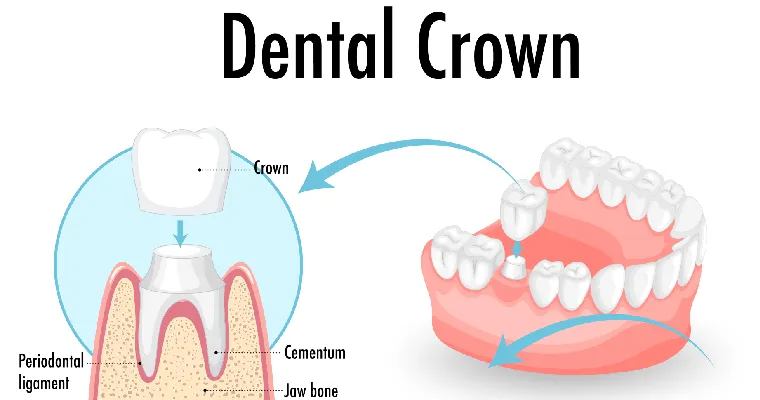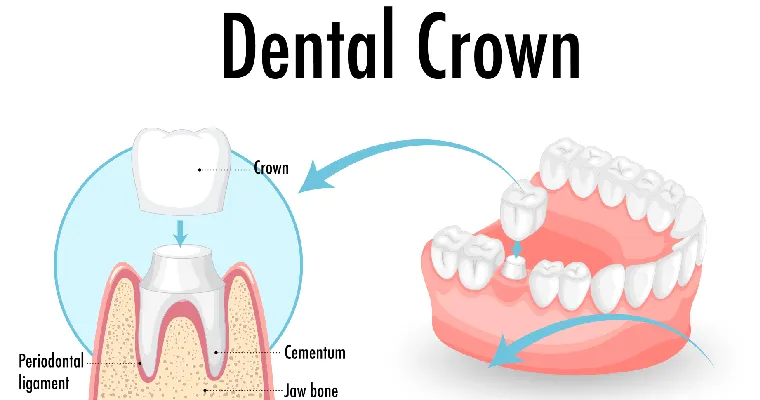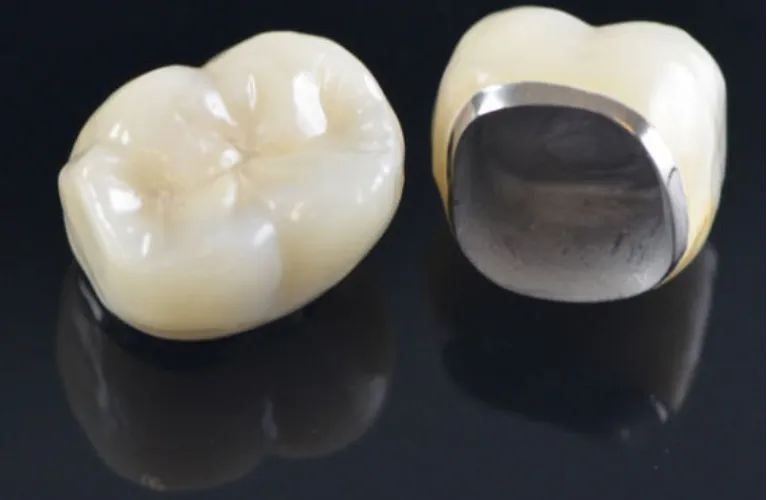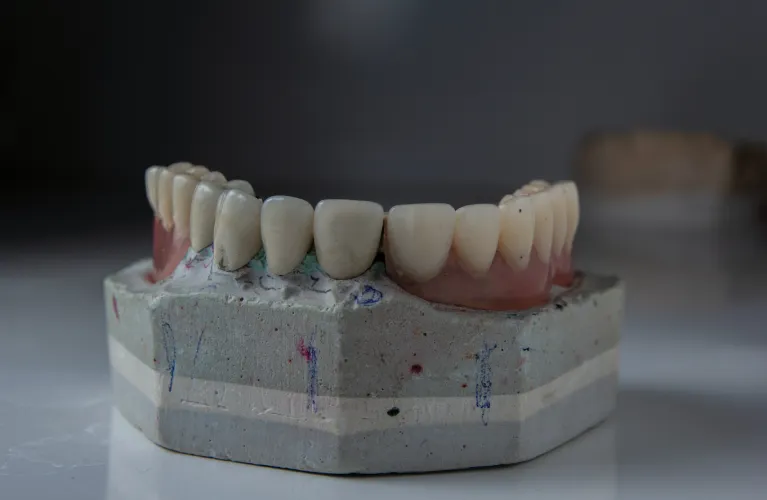
Dental Crown Types, Procedure, When It’s Done, Cost, and Aftercare | Dental Crown In Vadodara
Typically crowns cover damaged teeth. It can produce this from many materials – such as porcelain. You can wear permanent crowns to your molars that rarely show up except in the most extreme situations and you can use temporary crowns on the inside of the out-of-sight molars of your mouth that match your own teeth.
A natural look without a dull smile is arguably another factor to consider when choosing which types of dental crowns are needed. Having the right dental assistant can give you the option of getting more care.

Why a dental crown Is Needed
- Protect the weak teeth
- Protect and support the chipped and broken tooth. tooth
- Restore a loose crown, worn tooth or broken tooth
- Hold a dental bridge in place
- Cover Sever stained and discolored tooth
- Cover Root canal treated
- On Dental Implant
- Protect the Large Restoration
- Gaps between two teeth
Types of Dental crowns | Dental Crown Treatment In Vadodara
The filling material and crown of the front and back teeth is available in a variety of sizes. It depends upon your individual needs and your oral health.
Metal crowns In Vadodara
For crowns, dentistry technicians use various types of metal, such as gold and platinum. Unlike porcelain all ceramic crowns, porcelain-plated metal crowns , are durable for the same teeth at least twice the most prolonged period of wear, and only require minor elastomer removals. They may also endure chewed force.
The metallic colours represent the major disadvantage of almost all porcelain crowns. Metal molar crowns are an ideal choice for invisible teeth.

Porcelain Fused to Metal Dental Crowns (PFM) In Vadodara
These are India’s largest dental implants and crowns. These have a metal alloy base which provides stability layered with an artificial tooth or natural tooth re-coloured porcelain aesthetic. They can manufacture metal bases either through lost-wax techniques or CAD/CAM techniques.

All-ceramic or porcelain crowns | Zirconia Crown in Vadodara
The porcelain-encrusted, all-metal crowns mimic tooth enamel better than any other dental all-metal crowns rarely chip type. These are also all ceramic crowns great for people with metal allergies.
Lab technicians often use a variety of materials when producing their base metal alloys, ceramics, and crowns, but most commonly, zirconium oxide. Zirconia crowns are very strong and withstand more force than all ceramic crowns. Softer teeth are also gentler, which reduces tooth wear and gum damage.

All-resin crowns {Temporary crown}
Dental crowns made of porcelain fused with metal and resin are less expensive than other types of crowns. But they’re fragile and more likely to break compared to porcelain-fused-to-metal (PFM) crowns.
Dentists often use resin to make temporary dental crowns. They say temporary dental crowns last three to five years on average.
Same-day dental crowns | CAD CAM crown In Vadodara
Almost every dental office has CAD or CAM technology in place to put the same-day crowns back on. The software enables a dental practitioner to take an impression digitally of a prepared tooth and use that impression to design a new crown.
If you want to create the crown, the dentist’s office will put them into a mill. The machine creates your new crown from solid ceramic blocks. A major advantage of CAD and CAM technology is that dental crowns are available at a single dentist’s office every visit. But everyday crowns are not for all people. Ask your dentist about your options.

What happens during Dental Crown Procedure ? Dental Crown In Vadodara
First Visit
To prepare a tooth for a dental crown, the Dentist will remove some amount of the Enamel and dentin this space is for the tooth preparation for a new crown which will be a strong dental permanently cemented and put in that place. The focus will be on making the tooth have a strong foundation for the new permanent crown.
In the Next Step, the Dentist will visit your dentist to make a final Impression which will be a putty impression or Digital Impression . and they will make bite registration for dental implants.
Temporary crown Placement until the final crown placement will come
Second Visit
When the dental Lab finishes the temporary and permanent crowns both, the Dentist immediately removes the temporary crowns. Will check the shape, size, and tooth shade of the opposing tooth with the permanent crown, and Final Cementation done.
What are the benefits of Dental Crown
Protection and Restoration:
- Dental crowns are used to protect and restore damaged teeth. They provide a strong and durable covering that encases the entire visible portion of a tooth, strengthening the weak tooth, and preserving its structure. Crowns are often recommended for teeth with extensive decay, fractures, or weakened enamel.
- Improved Aesthetics: Crowns can enhance the appearance of teeth by improving their shape tooth color, size, color, and alignment. They are custom-made to match the natural color of your teeth, ensuring a seamless and natural-looking smile.
- Strengthening Weakened Teeth: Teeth that have undergone root canal treatment or have large fillings may become weakened and more prone further decay or to fractures.
- Longevity: When properly cared for, dental crowns can last for many years, providing a long-lasting solution for tooth restoration. The lifespan of a dental crown needed however can vary depending on factors such as oral hygiene, habits of tooth decay (such as teeth grinding), and the materials used.
- Improved Functionality: Crowns can significantly improve the functionality of teeth by restoring their ability to bite and chew properly. This is especially relevant when treating severely damaged or severely worn-down teeth, where crowns can rebuild the tooth structure, enabling better oral function.
- Comfort and Convenience: Dental crowns are custom-made to fit your unique bite and oral anatomy. They are designed to provide a comfortable and natural fit, allowing you to speak and eat with ease. Moreover, once the crown is placed, it requires no special maintenance other than regular good oral hygiene practices like brushing, dental floss-ing, and routine dental check-ups.
What are the disadvantages of dental crowns?
- Require some removal of natural tooth enamel.
- May cause Teeth Sensitivity or Tooth Pain
- Tooth-sensitive teeth are possible in those that cannot get root canal treatment. Dental Caps will assist with the bridge or restoration. In general, the sensitivity decreases within days following the fixing of the dental cap. Nevertheless, when the pain is intense or continuous, contact our dentist for urgent attention, especially in the first few weeks after placement.
- Can break or fracture.
- Can trap bacteria and lead to decay if they don’t fit properly.
- May cause an allergic reaction in some people. (This is rare.)
- May be expensive.
- Inability to Bite Properly or Change in Bite
- You may notice the biting after the cap or crowned tooth is replaced. It can be adjusted easily if the dental cap holder is checked. Once caps are fixed, if one is feeling fresh and new it will be accustomed within a day. If your bite has not improved, see your dentist for an appointment.
FAQ
How long do dental crowns last?
The materials used on the crown are also factors. Crowns from porcelain last for five to 15 years. The metal crown has a lifespan of at least 20 years. Crowns crafted of zirconic and gold are long-lasting.
Are dental crowns painful?
I’d like to know if it’s true. The dentist will anaesthetize and numb the teeth. Once the crown has worn off, we may have felt the sedative as irritation or as tooth sensitivity.
What are the disadvantages of dental crowns?
Cons. Expenses. Crowns have some disadvantages that they may cause. … Nervous harm can be very high. Having too thin teeth can cause nerve damage. … Sensitiveness. Dental crowning can cause damage to other teeth and can be very painful. … Potentially needed repair. Costs. We often regard crowns as expensive. … Risks of nerve damage. It is possible that teeth are too thin or they can cause nerve injury. The “Family of the People”, a group of women, consists of three – four-person groups of people, each representing a group of individuals and groups of people. Sensibility. A crown can also harm other teeth by being excessively abrasives. . Possibly need to repair the damage.
What does a dental crown do?
Dental crowns are caps made up of teeth that restore a damaged tooth. Dentists sometimes make temporary crowns used for dental implant treatments.
How long does a cap stay on a tooth?
They should wear dental crowns for about 15 years if properly inspected and maintained. If a patient takes a careful look at their dental crown, it could last for 30 years. Crown porcelains last between 5 and 15 years.
Is tooth capping painful?
While dental crowns protect teeth from damage, they can cause discomfort and infect the surrounding tissues and the normal. While tooth crown pains can be painful, the discomfort can be easily relieved using medications or follow-up dental treatment.
Is it good to cap a tooth?
Protected at last. A Crown is more resistant sometimes than other dental procedures. This helps prevent tooth decay by protecting them against future decay.
What is a cap for a tooth?
Crowns in teeth have an oval shape. A dentist uses crowns to repair damaged teeth. A crown covers the entire tooth as if the crowned tooth were wearing a hat. For a proper fit, the dentist should remove small amounts of the enamel from the tooth-shaped cap crown.
How painful is a dental crown procedure?
Many people fear going back to their dentists because they fear that their treatment will hurt, which is like getting your crown. Getting a crown is a relatively painless process from the initial consultation. You’ve had your mouths removed before you have your DR.
What is the process of fitting a dental crown?
During your first consultation, your dental team will take an impression of your tooth and fit your new crown. At the corresponding appointment, a dentist can place the temporary crown back on. The average wait between the two meetings is approximately two weeks.
Is putting a crown on painful?
Many doctors have been told they are in pain because we need their crowns for a period. It’s a quick procedure that’s simple: the dentist will make you as comfortable as you can as much as possible.
Is it good to have a crown on your teeth?
Crowns will last a long time! Having your teeth cleaned will reduce the likelihood of tooth decay. Teeth-whitening. A dentist typically uses porcelain for their crowns.
What are the benefits of crown treatment?
We commonly inserted dental crowns to help prevent or correct a surgical wound and they also have cosmetic advantages. Since we placed it on a tooth, it is easy to remove discoloured teeth and crooked and or chipped crowns too.
What are the pros and cons of a crown?
Let us describe some pros and cons of using a few porcelain crowns below. . Pro: Forms into natural teeth shape.Pro: Easily spotted. … No allergy. … a Con: Porcelains have a tendency to crack. … The original teeth are now broken up in a much deeper way. … Con: This causes increased heat and cold resistance. Easily made to the shape of natural teeth. … Pro: Very hard. … Pro: There’s no allergy. … Pro: Porcelaine may seem brittle. The term “foot” (or ” foo”) is used to refer to any term used in the history of the world of the human race. Cons of removing the original teeth. ‘. Con: Increases sensitivity to warm or cold air. Symptoms.
How long will a dental crown last?
Dental crowns can last 15 to 20 years if maintained properly. We can keep the crown clean for a lifetime unless shaved and cleaned regularly. Crowns crafted from porcelain will last between five and 15 decades.
What is the difference between a prosthodontist and a dentist?
Dental crowns. Crowns are helpful for the relief of pain. We used crowns many times for restorative treatments and restoration of enamel.
We can perform quickly crown Dentistry.
We can customize crowns to suit your needs.
We used crowns in tooth restoration for cosmetic reasons.
Dental crowns last long.
Crowns help ease the pain.
They commonly used a tooth crown as the last stage of re-infection or to repair the tooth’s ageing enamel.
I can do quickly dental crowning and safely.
Your Crown is custom-crafted to your exact specifications.
Crowns may enhance a person’s look. Dental crowns last for ages.
Is crown safer than filling?
Crowns have substantially stronger material than fillings, so they will not break. Because the crown ties up over the tooth, the crown is typically more secure compared to large fillings.
Which type of tooth crown is best?
Gold crowns are stronger and more durable than metal crowns, and dentists can also reduce their thickness. Although gold crowns are gentler than metal crowns, they make it much easier to clean the opposite teeth.
What type of crown lasts the longest?
A metal crown smashed but has a longer lifetime. Besides this, they will withstand the choking force. The metallic color represents a key disadvantage of the crown. We can use metal crowns in molars without vision.
What are the indications for ceramic crowns?
Front teeth that have fractured, discoloured, damaged or in poor condition. They made deep cuts, enabling better orientation. Ceramic crowns need to have layers 1.5–2mm thick.
What is the indication of crown after RCT?
Crowns typically require less tooth structure following root-cutting procedures. When half a tooth has been lost, it should be treated for restoration of the dental integrity.
What is the indication of crown vs onlay?
How can we choose onlays or crowns? Onlays can restore weakened teeth with minimal pain. Typically rearranging a cusp is necessary. In some cases crowns can be the only alternative if the adjacent teeth themselves are damaged or decay too rapidly.
